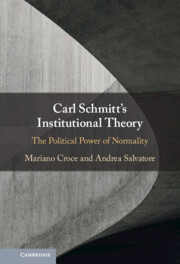Book contents
- Carl Schmitt’s Institutional Theory
- Carl Schmitt’s Institutional Theory
- Copyright page
- Contents
- Acknowledgements
- Introduction
- 1 What Is Exceptionalist Decisionism?
- 2 Looking Backwards
- 3 How Exceptionalist Decisionism Came About
- 4 A Fresh Start
- 5 Out of the Exceptionalist Quagmire
- 6 The Politics of Normality
- 7 Doing Away with Politics
- Conclusion
- References
- Index
2 - Looking Backwards
Schmitt before Exceptionalist Decisionism
Published online by Cambridge University Press: 23 June 2022
- Carl Schmitt’s Institutional Theory
- Carl Schmitt’s Institutional Theory
- Copyright page
- Contents
- Acknowledgements
- Introduction
- 1 What Is Exceptionalist Decisionism?
- 2 Looking Backwards
- 3 How Exceptionalist Decisionism Came About
- 4 A Fresh Start
- 5 Out of the Exceptionalist Quagmire
- 6 The Politics of Normality
- 7 Doing Away with Politics
- Conclusion
- References
- Index
Summary
Chapter 2 focuses on Schmitt’s early output (1910–21), in particular Über Schuld und Schuldarten. Eine Terminologische Untersuchung (On Guilt and the Types of Guilt: A Terminological Investigation) (1910) and Statute and Judgment: An Investigation into the Problem of Legal Practice (1912). The chapter illustrates how, between the 1910s and the beginning of the 1920s, Schmitt’s conception of law and legal practice was scarcely reconcilable with the exceptionalist decisionism of Political Theology (1922). By rejecting a ‘continuist’ interpretation, the chapter claims that Schmitt’s Political Theology effected a break with his prior theorisation, whereas his writings from the 1910s anticipated constitutive features of his legal institutionalism of the 1930s, particularly the close relation between normality and the judicial practice. Further, the chapter makes the case that the so-called ‘decisionist period’ (1921–8) can be portrayed as exclusively decisionist only if one neglects a few important lines of thought that Schmitt developed in other texts from those same years. Finally, even if one remains blind to the various tensions between Schmitt’s various lines of thought between 1921 and 1928, the books that open and close that period, namely, Dictatorship (1921) and Constitutional Theory (1928), do not lend themselves to a decisionist interpretation.
- Type
- Chapter
- Information
- Carl Schmitt's Institutional TheoryThe Political Power of Normality, pp. 27 - 46Publisher: Cambridge University PressPrint publication year: 2022

